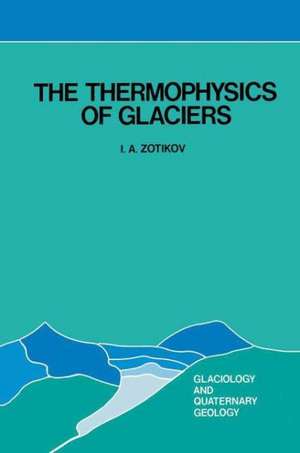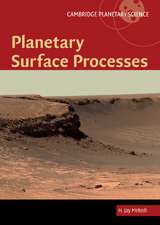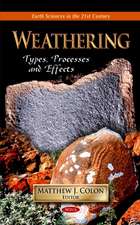The Thermophysics of Glaciers: Glaciology and Quaternary Geology, cartea 2
Autor I.A. Zotikoven Limba Engleză Hardback – 30 iun 1986
| Toate formatele și edițiile | Preț | Express |
|---|---|---|
| Paperback (1) | 1216.65 lei 6-8 săpt. | |
| SPRINGER NETHERLANDS – 27 sep 2011 | 1216.65 lei 6-8 săpt. | |
| Hardback (1) | 1222.62 lei 6-8 săpt. | |
| SPRINGER NETHERLANDS – 30 iun 1986 | 1222.62 lei 6-8 săpt. |
Preț: 1222.62 lei
Preț vechi: 1491.00 lei
-18% Nou
Puncte Express: 1834
Preț estimativ în valută:
233.96€ • 245.38$ • 194.76£
233.96€ • 245.38$ • 194.76£
Carte tipărită la comandă
Livrare economică 01-15 aprilie
Preluare comenzi: 021 569.72.76
Specificații
ISBN-13: 9789027721631
ISBN-10: 9027721637
Pagini: 292
Ilustrații: XII, 276 p.
Dimensiuni: 170 x 244 x 21 mm
Greutate: 0.59 kg
Ediția:1986
Editura: SPRINGER NETHERLANDS
Colecția Springer
Seria Glaciology and Quaternary Geology
Locul publicării:Dordrecht, Netherlands
ISBN-10: 9027721637
Pagini: 292
Ilustrații: XII, 276 p.
Dimensiuni: 170 x 244 x 21 mm
Greutate: 0.59 kg
Ediția:1986
Editura: SPRINGER NETHERLANDS
Colecția Springer
Seria Glaciology and Quaternary Geology
Locul publicării:Dordrecht, Netherlands
Public țintă
ResearchCuprins
1: Observations of the Thermal Regime of Glaciers.- 1.1. Measurements of Temperatures Inside Glaciers.- 1.2. Sources of Errors During Temperature Measurements in Glacier Boreholes.- 2: Thermal Drilling of Glaciers.- 2.1. The Theory of Drilling by Contact with a Heated Solid Surface.- 2.2. Methods of Thermal Drilling of Ice.- 2.3. Antifreeze Thermal Drilling by Direct Contact with a Solid Heater.- 3: The Theory of the Thermal Regime of Glaciers.- 3.1. The Fundamental Equations and Conditions Describing the State of a Glacier.- 3.2. Equations of Motion of Viscoplastic Ice.- 3.3. Internal Heat Sources Created by Ice Motion.- 3.4. Uniqueness Conditions.- 3.5. Simplifying the Equations. Dimensionless Numbers..- 4: The Temperature Field in a Flat Two-Dimensional Glacier With Block Sliding.- 4.1. A General Expression for the Temperature Field. Kinematics of a Glacier..- 4.2. Accurate Solutions for the Temperature Field.- 4.3. Mean Temperature of a Glacier.- 4.4. Temperature Gradients in the Glacier Interior.- 4.5. The Effect of the Dissipation Function.- 5: Approximate Methods for Studying the Temperature Field in a Flat Two-Dimensional Glacier With Block Sliding.- 5.1. The Method of Polynomials.- 5.2. The Temperature Field in a Glacier with a Varying Surface Temperature.- 6: The Thermal Regime of Glaciers.- 6.1. Thermophysical Studies of Accumulation-Ablation at the Upper and Lower Surfaces of Glaciers.- 6.2. Boundary Conditions at the Lower Surface of an Inland Glacier.- 6.3. Heat Sources Participating in the Heat Balance at the Bottom of a Glacier.- 7: The Thermal Regime of Inland Ice Caps.- 7.1. The Thermal Regime of the Antarctic Ice Sheet.- 7.2. Numerical Modeling of the Temperature Field of an Ice Cap.- 8: The Thermal Regime of Mountain Glaciers.- 8.1. The Melting of aContaminated Glacier Surface.- 8.2. Water in Mountain Glaciers.- 9: The Thermophysics of Ice Shelves.- 9.1. Melting at the Bottom of an Ice Shelf.- 9.2. Freezing at the Bottom of an Ice Shelf.- 9.3. Thermophysical Studies of Melting and Freezing at the Bottom of the Ross Ice Shelf.- 10: Applications of the Thermophysics of Glaciers.- 10.1. The Thermal Pollution of Ice Caps with Heat-Emitting Industrial Wastes.- 10.2. Reconstruction of the Quaternary Inland Ice Sheet of Europe.- References.



















